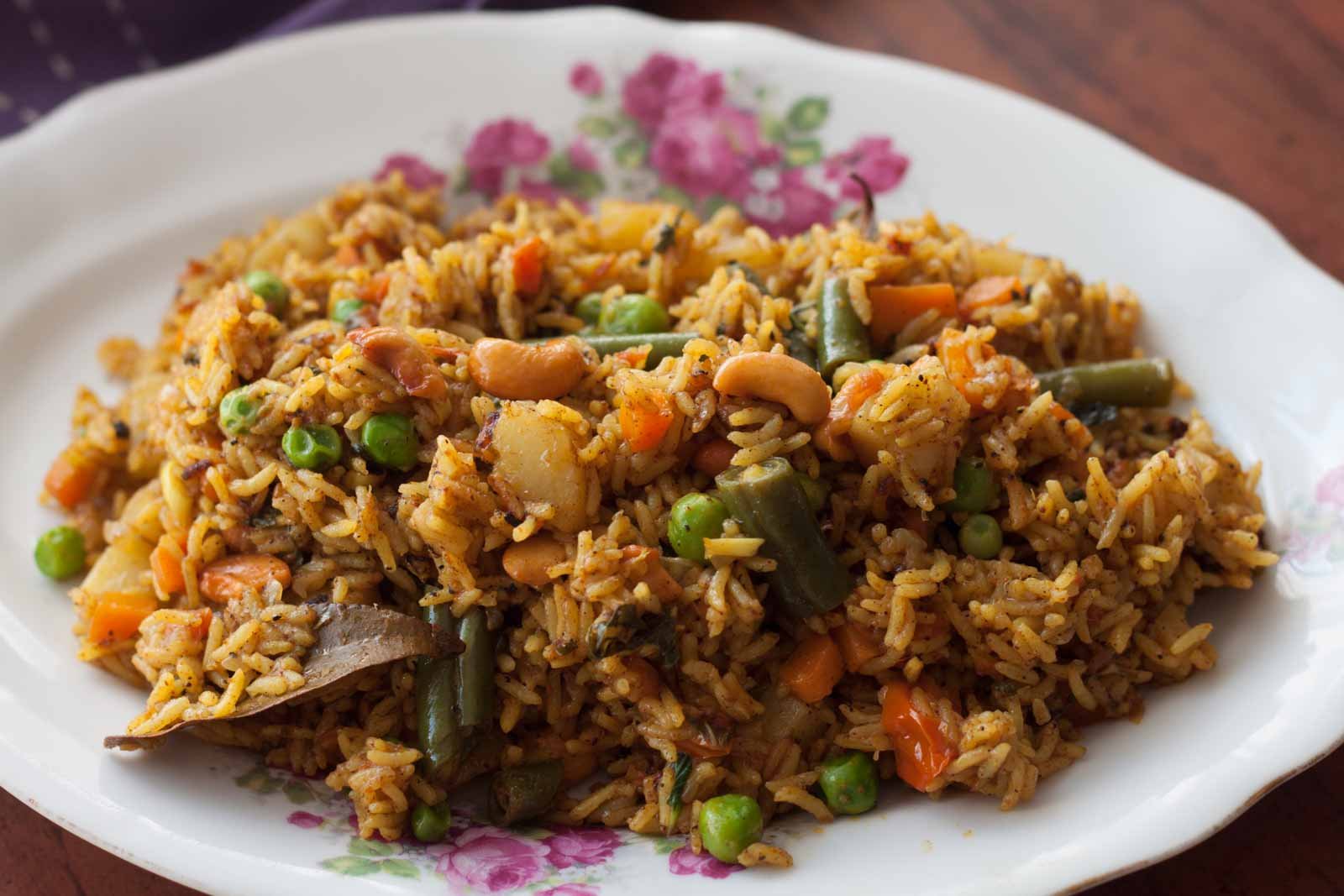Embark on a culinary adventure with our tantalizing Veg Biryani recipe in Tamil, a vibrant and aromatic dish that captures the essence of Tamil cuisine. With its delectable blend of fragrant spices, tender vegetables, and fluffy rice, this vegetarian delight is sure to tantalize your taste buds and leave you craving for more.
In this comprehensive guide, we’ll unveil the secrets behind this beloved dish, providing you with step-by-step instructions, ingredient insights, and cultural context. So, gather your ingredients, don your apron, and let’s delve into the world of Veg Biryani.
Ingredients
A delectable vegetarian biryani demands a symphony of flavors and textures, achieved through a careful selection of ingredients.
Here’s a comprehensive list of the essential components:
Vegetables
- 2 cups basmati rice, soaked for 30 minutes
- 1 cup mixed vegetables (carrots, peas, green beans, potatoes)
- 1 onion, chopped
- 2 tomatoes, chopped
- 1 green chili, chopped (optional)
Spices
- 1 tablespoon garam masala
- 1 teaspoon turmeric powder
- 1 teaspoon red chili powder
- 1 teaspoon cumin powder
li>1 teaspoon coriander powder
Herbs
- 1 bunch cilantro, chopped
- 1 bunch mint, chopped
Dairy Products
- 1 cup plain yogurt
- 1/2 cup milk
- 1 tablespoon ghee or vegetable oil
Step-by-Step Instructions
Preparing a flavorful and aromatic Veg Biryani involves a series of carefully executed steps.
By following these detailed instructions, you can recreate this classic dish in the comfort of your own home.
Preparing the Vegetables
- Rinse and chop a variety of vegetables such as carrots, peas, potatoes, cauliflower, and green beans into bite-sized pieces.
- Marinate the vegetables in a mixture of yogurt, ginger-garlic paste, turmeric, red chili powder, coriander powder, cumin seeds, and salt for at least 30 minutes.
Cooking the Rice
- In a large pot or Dutch oven, bring water to a boil and add the rinsed basmati rice.
- Cook the rice according to the package instructions until it is tender but still has a slight bite to it.
- Drain the rice and set it aside.
Assembling the Biryani
- In the same pot, heat some oil and sauté the marinated vegetables until they are tender.
- Add the cooked rice to the pot and gently mix it with the vegetables.
- Top the biryani with fried onions, cilantro, and mint leaves.
- Cover the pot and cook over low heat for 15-20 minutes, or until the biryani is heated through.
Cooking Techniques

Veg Biryani involves a combination of cooking techniques that enhance its flavors and textures. These techniques include sautéing, simmering, and layering.
Sautéing involves cooking ingredients in a pan over medium heat, stirring occasionally. This technique is used to brown the vegetables and release their natural flavors.
Simmering
Simmering is a gentle cooking method where liquid is brought to a boil and then reduced to a low temperature, just below the boiling point. This technique is used to cook the rice and vegetables until they are tender and absorb the flavors of the spices.
Layering
Layering is a crucial step in assembling Veg Biryani. The cooked rice, vegetables, and spices are arranged in layers in a pot or baking dish. This allows the flavors to mingle and create a harmonious blend.
To achieve the best results, it is important to sauté the vegetables thoroughly to develop their flavors. Simmering the rice and vegetables should be done over low heat to prevent burning and ensure even cooking. Finally, layering the ingredients carefully will result in a visually appealing and flavorful biryani.
Variations and Substitutions
Veg Biryani is a versatile dish that allows for numerous variations and substitutions. Experimenting with different ingredients and flavors can create unique and delicious versions of this classic dish.
Vegetable Variations
- Peas and Carrots: Add frozen or fresh peas and carrots for a colorful and crunchy addition.
- Corn: Add sweet corn kernels for a slightly sweet and juicy texture.
- Spinach: Stir in chopped spinach leaves for a boost of greens and a vibrant color.
Spice Substitutions
- Garam Masala: If you don’t have garam masala, use a blend of cumin, coriander, cardamom, cloves, and cinnamon.
- Ginger-Garlic Paste: Substitute with fresh ginger and garlic if you don’t have the paste.
- Yogurt: If you don’t have yogurt, use buttermilk or sour cream instead.
Impact of Variations
These variations can alter the flavor and texture of the Veg Biryani. For example, adding peas and carrots will provide a slightly sweet and crunchy texture, while spinach will add a touch of bitterness and a vibrant green color. Substituting spices with individual ingredients may slightly change the overall spice profile of the dish.
Serving Suggestions

Veg Biryani is a versatile dish that pairs well with a variety of accompaniments. Here are some traditional sides to enhance your dining experience:
Raita
Raita is a refreshing yogurt-based condiment that complements the rich flavors of Biryani. It is typically made with grated cucumber, onions, tomatoes, and spices, providing a cooling and tangy contrast.
Chutney
Chutney adds a spicy and tangy element to Biryani. Popular choices include mint chutney, coriander chutney, or tamarind chutney. These chutneys provide a burst of flavor and help balance the richness of the dish.
Papadum
Papadum is a crispy lentil-based flatbread that serves as a perfect accompaniment to Biryani. It can be enjoyed plain or paired with chutneys for an extra layer of flavor.
Creating a Complete Meal
To create a complete meal, consider serving Veg Biryani with a variety of dishes. Start with a refreshing appetizer such as samosas or pakoras. Follow with a side of raita and chutney, and add a green salad for a touch of freshness.
Complete the meal with a sweet dessert like kheer or gulab jamun.
Nutritional Information
Veg Biryani is a nutrient-rich dish that offers a balanced combination of carbohydrates, proteins, and healthy fats.One serving of Veg Biryani provides approximately:* Calories: 350-400
Carbohydrates
50-60 grams
Protein
15-20 grams
Fat
10-15 gramsThe dish is a good source of dietary fiber, which aids digestion and promotes a feeling of fullness. It also contains essential vitamins and minerals, including iron, calcium, and potassium.The vegetables used in Veg Biryani, such as carrots, peas, and potatoes, are rich in antioxidants and phytonutrients, which have anti-inflammatory and disease-fighting properties.
The spices used in the dish, such as turmeric and cumin, also have medicinal properties and contribute to the overall health benefits of the meal.
Cultural Significance
Veg Biryani holds a prominent place in Tamil culture, reflecting the region’s rich culinary traditions. Its origins can be traced back to the Mughal Empire, where it was introduced to Tamil Nadu during the 16th century. Over time, the dish has evolved to incorporate local flavors and ingredients, becoming a staple in Tamil cuisine.
Regional Variations
Veg Biryani is prepared differently across various regions of Tamil Nadu. In the northern districts, it is typically made with a blend of vegetables, including carrots, potatoes, peas, and beans. In the southern districts, the biryani often features a spicy tomato-based gravy and includes vegetables like eggplant and okra.
Regardless of the regional variations, the dish remains a beloved and widely consumed delicacy in Tamil Nadu.
Summary
As you savor the last bite of your homemade Veg Biryani, we hope you’ve not only enjoyed a delectable meal but also gained a deeper appreciation for the rich culinary heritage of Tamil Nadu. This dish, with its symphony of flavors and cultural significance, is a testament to the creativity and passion that define Tamil cuisine.
May your future culinary endeavors be filled with the same joy and satisfaction that this Veg Biryani has brought you.
FAQ Section
What is the origin of Veg Biryani?
The exact origins of Veg Biryani are not entirely clear, but it is believed to have evolved from the non-vegetarian biryani dishes brought to India by the Mughals. Over time, vegetarian versions emerged, incorporating a diverse array of vegetables and spices.
Can I use other vegetables in this recipe?
Absolutely! Feel free to experiment with different vegetables based on your preferences. Some popular variations include adding peas, carrots, bell peppers, or cauliflower to the mix.
How can I make my Veg Biryani spicier?
If you desire a spicier biryani, you can increase the amount of chili powder or add additional spices such as cayenne pepper or paprika. Adjust the quantities to suit your taste buds.
